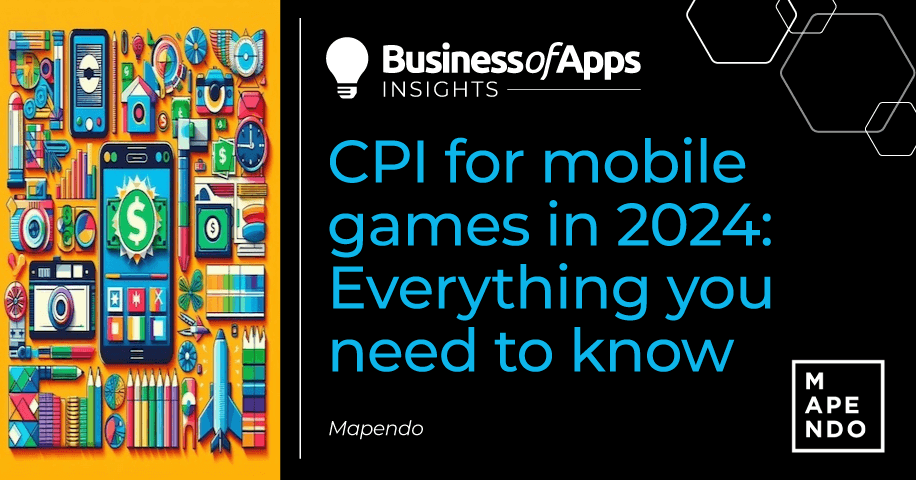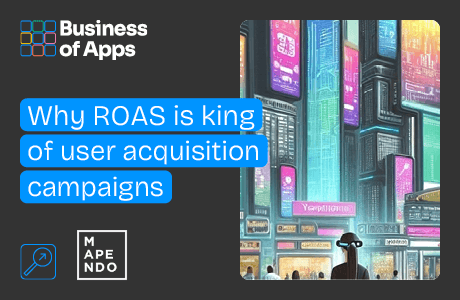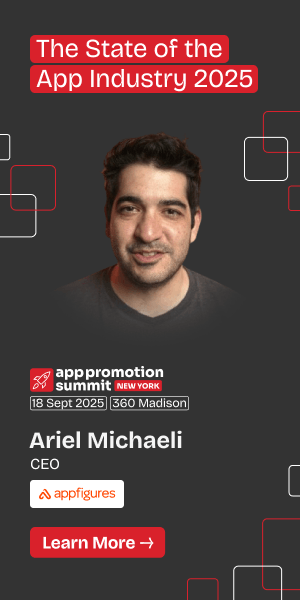In the 2024 digital landscape we live in, where mobile applications dominate the consumer market, the journey from conception to success for mobile games is overflowed with challenges. In a sea of competitors striving for users’ attention, Cost Per Install (CPI) for mobile games stands out because it provides insights into the effectiveness of mobile app marketing strategies.
CPI, the advertising cost necessary to get 1 install of your app, has emerged as a pivotal indicator of a campaign’s efficiency and return on investment (ROI). As the app ecosystem continues to evolve, understanding the intricacies of CPI is imperative for developers and marketers. In this in-depth analysis, we examine this metric to unravel the complexities surrounding CPI, delving into its significance, determinants, influencing factors and the strategies to optimize its efficiency.
By studying the features of CPI, we aim to develop actionable insights to navigate the competitive marketing landscape world behind CPI for mobile games and propel their endeavours towards sustainable growth and success.
What is CPI for mobile games
Cost Per Install (CPI) in the world of mobile games is a critical metric that influences the success or failure of a game’s marketing strategy. At its core, CPI refers to the cost incurred by developers to achieve 1 install of their game by a new user on their device. In the bustling ecosystem of mobile gaming, where competition is vicious and user acquisition is fundamental, Cost Per Install function is to guide developers through the labyrinth of possible marketing strategies.
Essentially, CPI for mobile games quantifies the financial investment required to entice users into downloading and installing the game, a fundamental step towards building a player base and monetizing the product. The calculation of CPI typically involves factoring in various expenses associated with user acquisition campaigns, including advertising costs across different channels such as social media, search engines, ad networks and incentivized installs.
Moreover, CPIs can fluctuate significantly depending on factors like the target audience’s demographics, geographic location, the genre of the game, seasonality, market trends, device specifics and the overall competitiveness within the gaming landscape. Understanding CPI is indispensable for game developers seeking to optimize their marketing budgets effectively, build a strong user acquisition strategy and ultimately drive sustainable growth and profitability for their games.
How to compute CPI for mobile games
Computing Cost Per Install (CPI) for mobile games involves a multifaceted process that encompasses various factors, methodologies and metrics. To begin with, it’s essential to understand that CPI is one of the fundamental metrics to look at, used by game developers and marketers to measure the efficiency and effectiveness of their user acquisition campaign.
At its core, CPI quantifies the cost incurred for each installation of a mobile game on a user’s device. The formula for computing CPI is relatively straightforward: it’s the total expenditure divided by the number of installs generated within a specified time frame. However, beneath this seemingly simple calculation lie a variety of intricacies and considerations that necessitate a more nuanced analysis.
First and foremost, determining the total expenditure involves meticulous tracking and analysis of all costs associated with user acquisition efforts. This includes expenses related to advertising across various channels such as social media platforms (e.g. Facebook, Instagram, TikTok, etc.), search engine marketing (e.g. Google Ads), ad networks (e.g. AdMob), influencer partnerships, affiliate marketing and incentivized installs. Each channel may have its unique pricing model, whether it’s based on impressions (CPM), clicks (CPC), actions (CPA) or installs (CPI). At this point, the calculation can be made both for every single channel and thus for the related CPI, and for the total cost aggregated.
Time for a MarTech health check
Is your MarTech stack fueling growth or wasting budget? Spot the issues and fix them fast with this free guide from the experts at ConsultMyApp.
Download nowNext, to compute the number of installs generated, developers and marketers rely on robust analytics and tracking mechanisms integrated into their mobile games. These analytics tools, such as MMPs, provide valuable insights into user behaviour, acquisition sources, conversion rates and other relevant metrics.
By leveraging tracking parameters, unique identifiers and attribution technology, they can attribute installs to specific marketing campaigns or channels accurately. This attribution process is fundamental for accrediting created installs to the specific campaign and for determining the effectiveness of each of these campaigns and optimizing future allocation of resources. It also enables a deep analysis of CPI across different demographics, geographic regions, platforms, devices and even specific ad creatives or targeting parameters.
Once the total expenditure and the number of installs are accurately determined, computing CPI simply involves dividing the former by the latter. Mathematically, CPI = Total Expenditure / Number of Installs. This basic calculation provides a high-level overview of the cost efficiency of user acquisition efforts.
Moreover, CPI analysis doesn’t end with a single computation. It’s an iterative process that requires continuous monitoring and optimization. Developers and marketers must track CPI over time, compare it against industry benchmarks and identify trends and patterns. By conducting A/B tests, and experimenting with different creatives, messaging, targeting parameters and bidding strategies, they can find their campaigns to improve performance and reduce CPI for mobile games.
What affects CPI for mobile games
The Cost Per Install (CPI) for mobile games is influenced by a multitude of factors, each applying its unique impact on the overall acquisition cost and campaign effectiveness:
- App category
- Country
- Platform
Firstly, the app category plays a pivotal role in determining CPI, as different categories and types of games attract distinct audiences with varying acquisition costs. For example, hyper-casual games, characterized by simple mechanics and quick gameplay sessions, often present lower CPI due to their broad appeal and high volume of organic installs; rather than niche or hardcore games, targeting specific enthusiast communities, that may incur higher CPI as they require more targeted marketing efforts to reach their ideal audience.
A sporadic situation to consider is seasonal trends, in which the market demand can significantly impact CPI for mobile games, with certain genres experiencing peak in demand during for example holidays or special events, driving up acquisition costs.
Moreover, the country of target audience holds considerable influence over CPI for mobile games, with disparities in purchasing power, user behavior and market maturity influencing acquisition costs. Tier 1 countries such as the United States, Canada and Western European nations typically command higher CPI due to their affluent user base and competitive advertising landscape.
Conversely, emerging markets such as Asia, South America and Africa may offer lower CPI but present unique challenges related to localization, cultural nuances and payment methods.
In addition to app category and country, the platform on which the game is launched, whether it’s iOS, Android or other platforms, play a significant influence on CPI for mobile games. Each platform has its own specific ecosystem, user base and monetization mechanisms, leading to divergent acquisition costs and marketing strategies.
iOS, known for its affluent user base and higher propensity for in-app purchases, often commands higher CPI compared to Android. The App Store’s stringent review process and premium positioning contribute to a more competitive landscape, driving up advertising costs. On the other hand, Android’s open ecosystem and wider user reach may result in lower CPI but pose challenges related to device fragmentation, piracy and lower conversion rates. Data show that, considering ROI, investing in the iOS market generates a return of 156% compared to the 120% return on Android.
The choice of platform can impact CPI also based on regional preferences and market share dominance. For example, while iOS dominates in markets like the United States and Western Europe, Android enjoys a stronghold in emerging markets like India, Brazil and Southeast Asia, necessitating platform-specific strategies to optimize CPI and user acquisition.
Mobile games CPI by country
Cost Per Install (CPI) for mobile games varies significantly from one country to another due to a multitude of factors ranging from market maturity and purchasing power to cultural preferences and competition levels.
In countries with developed economies such as the United States, Canada and Western European nations, CPI tends to be higher due to the affluence of the user base and the competitive landscape of mobile app marketing. CPI in the US and Canada amount to 3.16$ and 3.30$ per install, much more also than some Western European nations such as France and Spain (rock bottom for Europe with 1.10$ CPI). Users in these regions are more accustomed to spending on digital goods and services, driving up acquisition costs as developers strive for their attention through advertising campaigns across various channels.
Additionally, the presence of well-established gaming communities and a higher propensity for in-app purchases further contribute to the competitiveness of these markets, resulting in elevated CPI. Indeed, in emerging markets like India, Brazil, Southeast Asia and parts of Africa, CPI tends to be lower but presents its unique set of challenges and opportunities. Despite the lower acquisition costs, developers must navigate factors such as lower purchasing power, device fragmentation, cultural features and localization requirements to effectively monetize their games and drive sustainable growth.
Regional preferences, gaming habits and app store dynamics vary significantly across countries, necessitating tailored strategies to optimize CPI and maximize ROI in each market. By conducting market research, leveraging advanced analytics and adopting localized marketing approaches, developers can mitigate the impact of high CPI in mature markets and capitalize on the growth opportunities presented by emerging markets, driving optimization and profitability in the global mobile gaming landscape.
Mobile games CPI by app category
Cost Per Install (CPI) for mobile games exhibits notable variations across different app categories, reflecting the diverse user behaviours, preferences, and monetization models inherent to each genre.
Hyper-casual games, characterized by their simple mechanics and mass-market appeal, typically boast lower CPI compared to other genres. Their broad demographic appeal and high volume of organic installs contribute to lower acquisition costs, as developers can leverage viral sharing and word-of-mouth referrals to drive user acquisition at scale.
Hyper-casual games monetize through ads, with the main goal of having an enormous volume of users.
Conversely, niche genres such as hardcore strategy games or role-playing games (RPGs) often command higher CPI due to their specialized appeal and the need for targeted marketing efforts to reach their audience. These genres typically target a specific enthusiast community with distinct preferences and expectations, necessitating tailored advertising campaigns to attract and retain users. Differently from hyper-casual games, RPGs and strategy games monetize primarily through IAPs: indeed their main goal is not on the quantity of users, but rather on the quality of their new users, and this is the meaning for the high CPI they have
CPI for mobile games can fluctuate within app categories based on factors such as seasonality, market trends and competition levels. Differences in the category come also inside each platform: according to Publift’s report, CPI varies significantly between iOS games and apps (3.6% for apps and 4.3$ for games) and less on Android (1.22$ for apps and 1.15$ for games).
By understanding the specifics of CPI within each app category and adopting targeted marketing strategies, developers can optimize user acquisition efforts, drive sustainable growth and maximize ROI in the mobile gaming landscape.
Mobile games CPI by platform
Cost Per Install (CPI) for mobile games varies considerably across different platforms, primarily iOS and Android, each with its ecosystem, user base and monetization mechanisms.
iOS typically commands a higher CPI compared to Android due to several factors. Firstly, iOS users generally have higher purchasing power and are more willing to spend on digital goods and services, resulting in a more competitive landscape for user acquisition campaigns.
Additionally, the App Store’s stringent review process and premium positioning contribute to elevated advertising costs, driving up CPI for mobile games on iOS. Conversely, Android’s open ecosystem and wider user reach may lead to lower CPI, but developers face challenges related to device fragmentation, piracy and lower conversion rates. According to Business of Apps, games such as puzzle games experience much higher CPI on iOS (4.5$) rather than on Android (1.1$), with simulation games facing the same trend.
Furthermore, regional preferences and market share dominance impact CPI on each platform. While iOS dominates in markets like the United States and Western Europe, Android controls emerging markets such as India, Brazil, Southeast Asia and South America, influencing acquisition costs accordingly.
Conclusion
In conclusion, the analysis we made regarding Cost Per Install (CPI) for mobile games sheds light on the intricate dynamics of user acquisition in the ever-evolving landscape of mobile gaming. Through a comprehensive examination of factors such as app category, country and platform, developers and marketers gain valuable insights into the features of acquisition costs and campaign effectiveness.
From hyper-casual to hardcore games, from tier 1 countries to emerging markets, and from iOS to Android, CPI varies significantly, reflecting the diverse preferences, behaviours and economic realities of mobile gamers worldwide. provided with this understanding, stakeholders can devise tailored strategies to optimize CPI, maximize ROI and drive sustainable growth and profitability for their games.
As the mobile gaming industry continues to evolve, CPI analysis fosters innovation and drives excellence in marketing practices. By embracing data-driven insights and adopting a proactive approach to user acquisition, developers can position themselves for success in the market for mobile gaming, delivering engaging experiences to players worldwide while achieving their desired CPI for mobile games.











